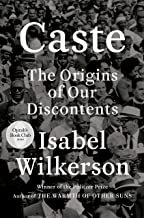Caste: The Origins of Our Discontents, Isabel Wilkerson 2020
This is an essentially important book that should be required reading for every adult in the U.S. At a time when a president of the U.S. gets away with and even is complimented for his comments about Mexican rapists and murderers, the ‘good people’ carrying Nazi flags and torches who murdered in Charlottesville, and how ‘white people are murdered by the police as well” and at a time of Black Lives Matter, this book provides two important elements. First, by framing American slavery, Reconstruction, Jim Crow, the current mass incarceration and murder of Black citizens, and the republican party’s attempts to limit voting in the conceptual construct of caste, it allows historical referencing as well as a framework for examining and understanding the current situation. Second, by its sometimes seemingly endless stories of individual cases of discrimination, harassment, and murder by lynching, it continuously pummels the reader until one begins to absorb the dimensions and scope of the situation.
Wilkerson, follows her Pulitzer Prize winning story of the Great Migration, with this extensively researched and deeply personal story of the African American experience in America. While not the first anthropologist or social scientist to use the term ‘caste’ to describe this situation, she more fully develops the theory in clearly understandable prose and applies it to current as well as historical parallels. She uses several very effective metaphors for the caste system comparing it to the operating system of a computer which has ‘adjustable software’ that can be altered over time. Caste creates structure, ranking systems, and boundaries that reinforce fixed assignments in the same way that ‘cast’ refers to the given roles in a drama. The 8 pillars of the system work together in synergy to produce the resultant discrimination: divine will and the law of nature, heritability, endogamy and the control of marriage and mating, purity and pollution, occupational hierarchy, dehumanization and stigma, terror as enforcement, and inherent superiority and inferiority.
Her comparison of America’s caste system to Hitler’s dehumanization and genocide of Europe’s Jews touched a particularly sensitive part of me. The notion of belonging and the consciousness and unconscious elements of caste in my own childhood and professional life were uncomfortable to consider. Why would I with my Harvard degree, my M.D., my years at Harvard Medical School running some of the world’s best hospitals, still feel uneasy when entering a room full of tall, white, wealthy, Episcopalian executives or trustees? Perhaps it’s because I’ve internalized a caste system that places Jews, while evidently ‘white’, as not quite as ‘white’ as the others? Perhaps, it’s because I’m still afraid of being dehumanized as members of my ‘family’ were in Germany less than a lifetime ago?
Wilkerson has, once again, given us something to think about and ponder. The overtly racist behavior and actions of trump and his white supremacist allies may well be easier to eradicate or at least minimize than the deeply felt and often unconscious biases that result from a caste system that functions to ‘keep people in their place.’
I’d urge everyone to read this book; talk about it with family, friends, and neighbors; and begin to shine the light of equal protection under the law and the golden rule on our fellow citizens who continue to suffer discrimination in today’s America.



